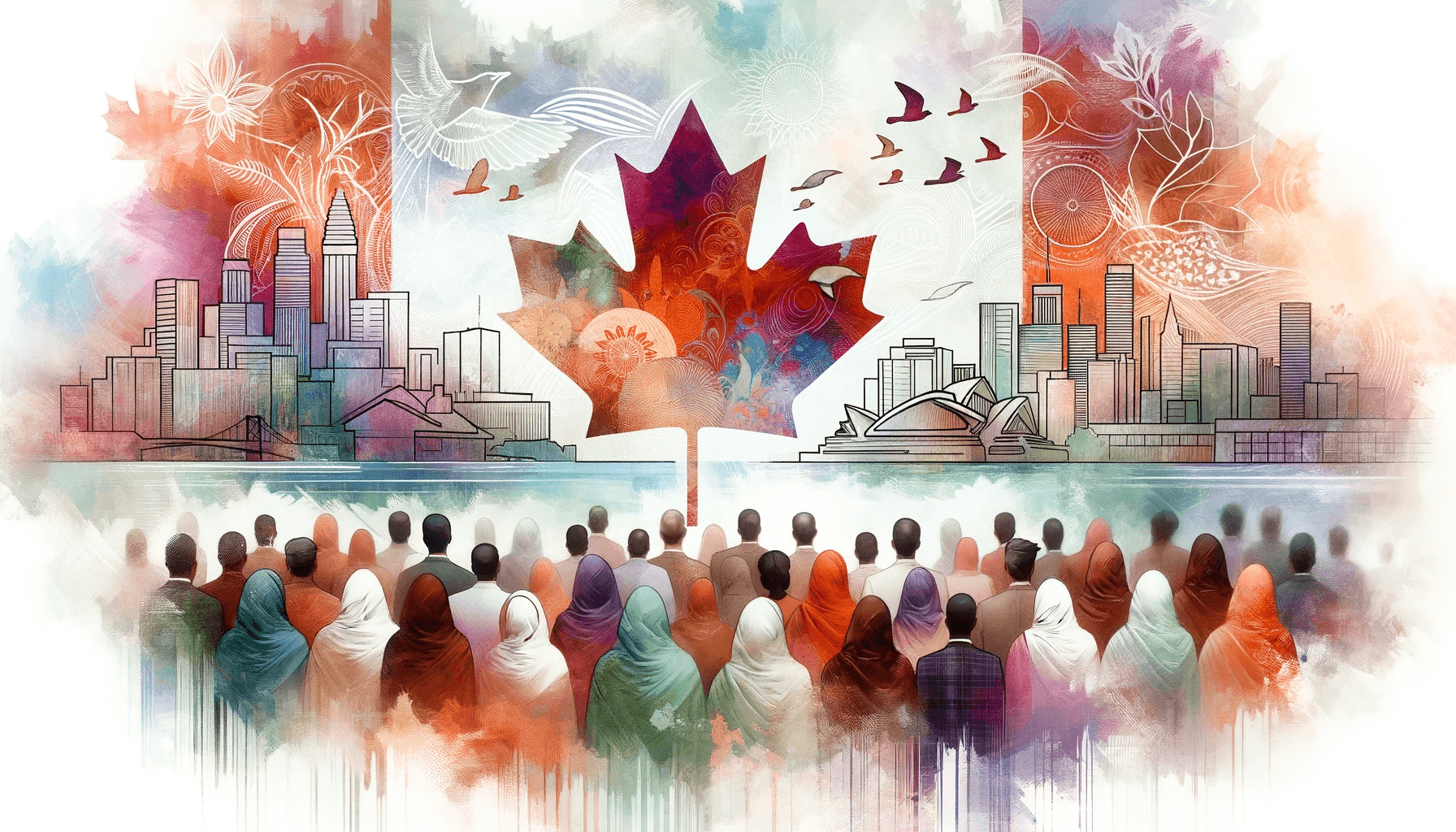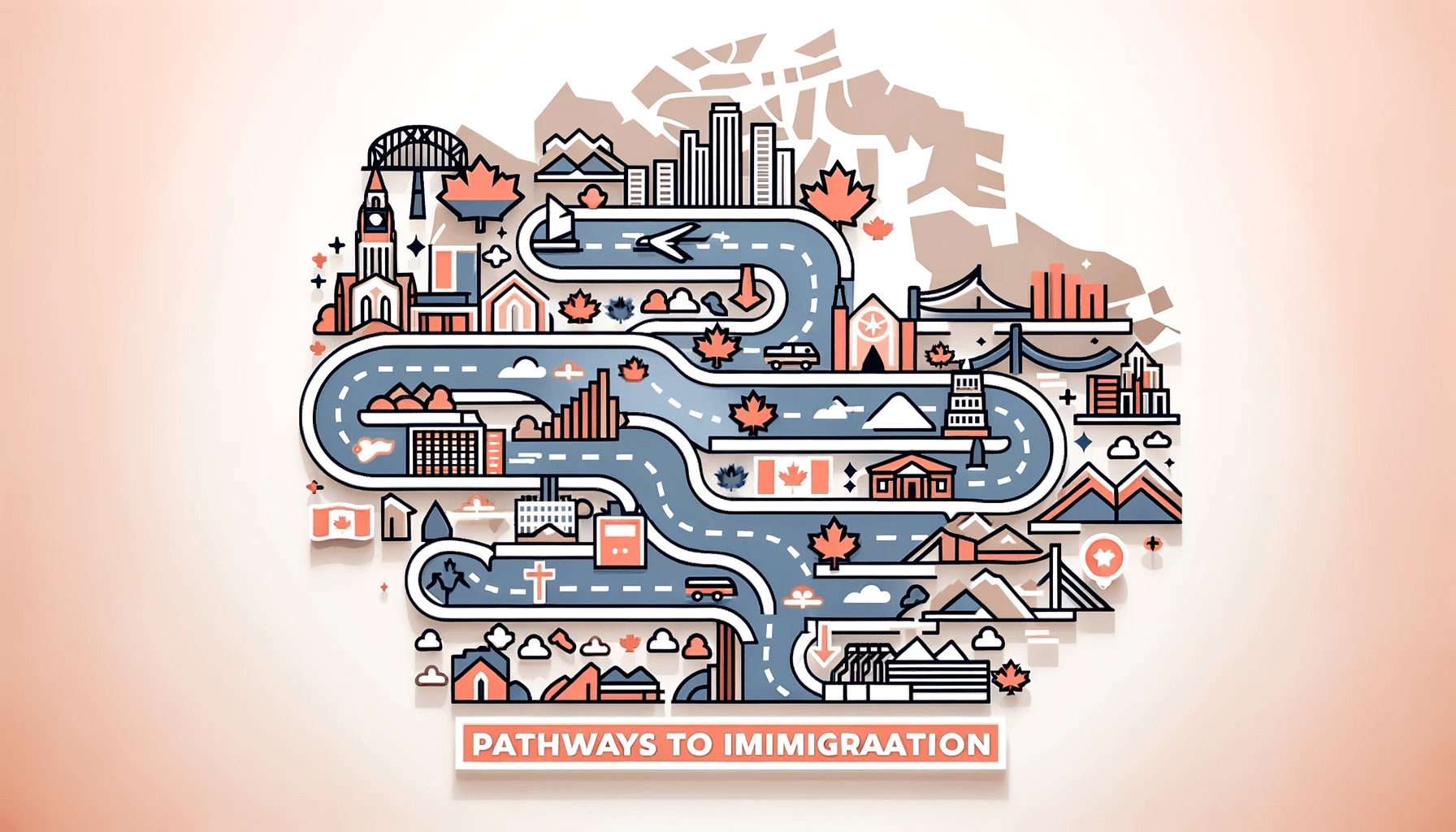Immigration to Canada from India: A Guide to Study, Work and Get PR!
Your Quick 30-Second Answer on Immigration to Canada from India!
For people from India looking to immigrate to Canada in 2024, several pathways are available. The Provincial Nominee Program (PNP) and Express Entry, offering opportunities for skilled, semi-skilled, and unskilled workers. Studying in Canada provides a path to permanent residency, especially under the Post-Graduation Work Permit (PGWP), allowing work in Canada after graduation. Work permits include the Temporary Foreign Worker Program (TFWP), requiring a Labour Market Impact Assessment (LMIA), and the International Mobility Program (IMP), which doesn't require an LMIA. Family-Class Sponsorship allows Canadian citizens and permanent residents to sponsor relatives. Special programs like the Caregivers Pilot Programs and Agri-Food Pilot offer specific occupational pathways, with the latter having lower language and educational requirements. Canada's immigration plan for 2024-2025 aims to welcome over 485,000 new immigrants in 2024 and 500,000 in 2025, encompassing economic, family, and refugee categories.
For an in-depth overview, please see the "Table of Contents" below.
Guide to Immigration to Canada from India: Study & Settle Easily
Welcome to this easy-to-follow guide on immigration to Canada from India: A comprehensive guide to immigrate, work or study! Primarily, this guide is for anyone who wants to learn about immigration to Canada from India. This guide is here to make everything clearer and simpler for you.
TABLE OF CONTENT
Intro: Immigration from India
1. Who should use this Guide?
2. Overview: Immigration Canada
3. Basics of Immigration Canada
Pathways to Immigration
4. The Express Entry System
5. Provincial Nominee Programs
6. Family Class Sponsorship
7. Studying in Canada
8. Working in Canada
Comprehensive Understanding
10. Realizing Your Dream
11. Fictional Case Example
Resources and Assistance
12. Frequently Asked Questions
13. Additional Resources

1. Who should use this Guide?
If you find the official rules and documents about the requirements to move to Canada confusing, this guide can be your helpful friend. It’s here to give you clear and easy help so you can understand how Canadian permanent residence works without any problem. This guide makes things simple, but it’s just a starting point to help you see the bigger picture without getting lost in too much information. It’s here to add to the official guides, not to replace them.
Immigration to Canada from India: 2024 Guidelines
1. Provincial Nominee Program (PNP)
- PNP is ideal for those not eligible for Express Entry. Each Canadian province offers unique streams for skilled, semi-skilled, and unskilled workers.
- Applicants must apply to the province, receive a nomination certificate, and then apply for permanent residence.
2. Study and Work Pathway
- Studying in Canada can lead to permanent residency. Indian students often become permanent residents within five years of receiving a study permit.
- Students need a study permit and may work up to 20 hours per week. The Post-Graduation Work Permit (PGWP) is available for certain study programs, allowing work anywhere in Canada.
3. Canadian Work Permits
- Work permits fall under two categories: the Temporary Foreign Worker Program (TFWP) and the International Mobility Program (IMP).
- TFWP requires an employer to obtain a Labour Market Impact Assessment (LMIA). The IMP doesn’t require an LMIA and focuses on Canada's broader economic goals.
4. Family-Class Sponsorship
- Canadian citizens and permanent residents can sponsor relatives, including spouses, children, or parents and grandparents.
- Sponsors must be financially capable and applicants must meet eligibility criteria.
5. Caregivers Pilot Programs and Agri-Food Pilot
- Special programs like the Caregivers Pilot Programs and the Agri-Food Pilot offer immigration pathways for specific occupations. The Agri-Food Pilot has low language requirements and a high school diploma is sufficient for education.
6. Canada's Immigration Targets
- Canada's immigration levels plan aims to welcome over 485,000 new immigrants in 2024 and 500,000 in 2025 across various categories including economic, family, and refugee programs.
These pathways offer diverse options for Indians considering immigration to Canada, each with specific requirements and application processes.
2. Overview of Immigration to Canada from India
1. Overview of Moving to Canada from India
Many people are choosing Canada as a new home because of its good jobs, top-class universities, and friendly people. This is especially true for people from India. This big move involves a lot of planning and following certain rules and steps. Understanding these steps is very important to moving smoothly from India to Canada.
2. Quick Look at Why Canada's Rules for Immigration to Canada from India are Attractive to People from India
Canada's rules for letting people in are well-planned and fair, and they aim to help the country grow by bringing in skilled people, students, and families wanting to live together. This is a big reason why many people from India find Canada a great place to live, study, and work.
Canada is known for welcoming people from different cultures, and there's already a large community of Indians there. This makes the move from India to Canada even more attractive.
Personal Journey: My Own Story of Moving to Canada
My own journey to becoming a Canadian started with big dreams and careful planning. I came to Canada as a student and went through many steps, like getting permission to study, extending that permission, working after graduation, and finally becoming a permanent resident and then a citizen.
It was not always easy. I missed home, had to get used to a new way of life, and worked hard in school and at jobs. But I found great support from other Indians in Canada, and the friendly Canadian way of life made things easier. My success in becoming a lawyer in Canada shows that with hard work, knowing how things work, and not giving up, anyone can make a new successful life in Canada.
Why This Information is Important: Helping You Understand
There's a lot of information out there about how to move to Canada, but a lot of it is basic and does not talk about the special concerns people might have regarding immigration to Canada from India.
Here, we talk about the details, giving you information that comes from having done it ourselves. We talk about things that most people do not know, helping you with the steps to take, preparing for life in Canada, and settling in well once you are there.
We understand that moving to a new country is a big decision filled with hope, excitement, and also a bit of worry. This is your guide, showing that you are not alone and that with the right information and support, your dreams are possible.
3. What are the Basics of Immigration to Canada from India?
The immigration process to Canada from India can appear confusing without a clear plan. Whether your aim is to study, work, or settle permanently, Canada's diverse set of immigration programs can be your pathway to a new life. Here's a deeper look at these programs, with a special focus on how they cater to applicants from India, acknowledging the growing trend of Indian nationals seeking Canadian residency.
Understanding the Concept of Permanent Residency (PR)
Permanent Residency, often termed as PR, is a status allowing someone to live and work in Canada indefinitely. For Indians looking to move to the land of maple leaves, acquiring PR is often the ultimate objective. Why? Because it offers the stability of long-term residence while providing most of the benefits of a Canadian citizen. It is like receiving an exclusive membership that grants you the right to live, work, and study anywhere in the country. It's a desired status, particularly among Indian citizens, due to Canada's high living standards, inclusive society, and growing job opportunities. However, it's crucial to recognize that this isn't citizenship; hence, while you can stay indefinitely, certain restrictions apply.
Pathways to Immigrate to Canada from India
India, being in the South Asian subcontinent, has historically seen a surge of its nationals looking for prospects abroad. Canada, with its welcoming policies, has always been a top choice. Over the years, immigration patterns and data reveal a consistent rise in Indian nationals making Canada their new home.
This is a system for fast-track immigration processing. The trend over the past few years indicates a higher number of Indian nationals securing a spot through the Express Entry system than any other country.
Imagine jumping ahead in a long line. That's what the Express Entry System is like. It's a way for skilled workers from India to go through the immigration process fast. This system looks at things like your job skills, education, and language ability and gives you points for them. The more points you have, the quicker your chance to immigration to Canada from India.
In recent years, a significant number of individuals from cities like New Delhi, Mumbai, and Bangalore have successfully embarked on their Canadian journey through this system, highlighting the pathway's effectiveness for skilled professionals from urban regions in India. However, competition is fierce. Applicants are ranked against each other, with high-scoring individuals—based on factors like age, education, work experience, and language proficiency—prioritized for invitations to apply for permanent residency.
2. Provincial Nominee Programs (PNPs):
Each province in Canada is like a mini-country, with its own needs and wants. Through PNPs, provinces can pick people who have the skills and talents they need. For instance, if a province needs teachers and you're a teacher, that province might pick you to come and live there.
Indian citizens have found particular success with PNPs in provinces like British Columbia and Ontario, both hubs for tech talent, and Alberta, known for its demand in the energy sector. For instance, British Columbia might be seeking tech professionals, a sector where cities like Hyderabad and Pune excel, whereas Alberta might be in search of healthcare workers. PNPs allow provinces to tap into this potential from specific countries, and India, given its diverse talent pool, naturally becomes a preferred source.
Family is important, and Canada knows that. That's why there's a Family Class Sponsorship program. If you have family in Canada, like a spouse, parent, or child, they can ask the government to let you come live with them.
Cities with high rate of immigration to Canada from India, such as Brampton and Surrey, often see a high number of family sponsorships, as families seek to reunite and enjoy a better quality of life. Given the strong familial bonds in Indian culture, many Indians in cities from Amritsar to Chennai often prioritize family reunification. As more Indians settle in Canadian cities like Toronto and Vancouver, the demand for family sponsorship increases.
4. Study Permit:
Canada has some of the world's best schools. To study there, you need a Study Permit. This is more than just permission to go to school – it's a ticket to learning new things, meeting people, and sometimes even staying in Canada after you graduate to find a job. Canadian credentials coupled with job experience gained through programs like Post-Graduation Work Permits can bolster an applicant’s eligibility for permanent residency. Canada's world-class education system is an attractive pull for Indian students.
Cities like Bangalore, known for their emphasis on education, see a steady stream of students moving to Canadian universities. Notably, Indian students frequently choose metropolitan areas like Toronto and Vancouver, known for their prestigious institutions and vibrant student life. This study in canada from India trend is a testament to the mutual benefits: Canada gets bright minds, and Indian students receive top-tier education.
5. Work Permits:
To work in Canada, you need an official paper called a Work Permit. This paper says you can work for a certain time, sometimes for a specific job. Getting a job offer from a Canadian company is a common way people from India move to Canada.
Analyzing the patterns, we see that tech industries and services sectors in cities like Toronto, Montreal, and Calgary have a high demand for skilled workers, often sourcing expertise from populous areas in India.
In some cases, this experience can facilitate a smoother transition to permanent residency, especially for occupations in high demand. With India being a hub for sectors like IT and healthcare, Canadian employers often seek talent from metropolitan areas like Kolkata and Gurugram.
In-Depth Insights and Strategy for Immigration to Canada from India
While these pathways provide structured routes into Canada, understanding the small details can increase your chance of success. For instance, keeping abreast of the occupations in high demand, both in specific provinces and Canada at large, can inform your education and career decisions before applying. Tailoring your skills to these needs not only increases your points in systems like Express Entry but also makes you a desirable candidate for job offers and provincial nominations.
Furthermore, language proficiency cannot be overstated. Improving language skills, particularly English and French, aligns with Canadian immigration policies' emphasis on communication, significantly boosting your eligibility.
Finally, it's beneficial to understand that Canadian immigration policies favor applicants who demonstrate a genuine intention to contribute to the economy and society. Whether through work, study, or family connections, showing your commitment to integrating into the Canadian way of life can be crucial.
All these strategies are drawn from a thorough analysis of historical data, reflecting trends and policies that have shaped successful immigration stories from India to Canada. These insights are not just steps but are woven from the fabric of previous applicants' experiences, designed to guide you on immigration to Canada from India.
4. The Express Entry System: A Popular Choice!

Immigration to Canada from India: Through the Express Entry System
A. What is the Express Entry System?
The Express Entry system is like a fast-track queue for skilled individuals wanting to immigrate to Canada from India. It doesn't just randomly select people; it chooses those who are most likely to succeed in Canada's dynamic work environment and society. This system has gained popularity due to its efficiency and clear, point-based method for evaluating candidates.
B. Can You Apply? Understanding Eligibility Criteria
Your ticket to enter this fast queue depends on several factors:
1. Skills: Are you good at something that's needed in Canada's job market? Skills don't just mean things you're trained in, but also what you're naturally good at.
2. Work Experience: How long have you been doing your job? Canada prefers people who've spent a good amount of time in their field, as it suggests they'll keep contributing to the same industry in Canada.
3. Language Ability: How well do you speak English or French? Good communication is key in Canada’s workplaces and communities.
4. Education: What level of schooling or training have you completed? Higher education often means more opportunities.
C. The Comprehensive Ranking System (CRS)
The CRS is a scoreboard. Every detail about you earns points – your age, education, job skills, work history, language skills, and more. The more you have to offer, the more points you score. Every so often, Canada invites the highest scorers to apply for permanent residency.
D. Your Journey Through the Express Entry Process
Here's how you travel through the Express Entry System for Immigration to Canada from India:
1. Creating a Profile: This is like your resume. You list all your details: skills, work history, language ability, education, and more.
2. Receiving an Invitation to Apply (ITA): If your score is among the highest, you get an ITA. This is Canada's way of saying, "We think you'll do well here. Want to come?"
3. Submitting the Final Application: This is where you provide proof of everything you claimed in your profile and wait for Canada to make its final decision.
Strategic Insights for Success
After looking at years of data and stories from individuals, it’s clear that success isn't just about meeting the minimum requirements. It's about standing out. For instance, while knowing English or French is necessary, being proficient in both can give you an edge over others. Similarly, Canadian work experience or education can be a golden ticket, significantly increasing your score.
It's also vital to stay informed about the occupations that Canada needs most at any given time. For example, tech jobs, healthcare, and skilled trades have historically been high in demand. Tailoring your skills to these needs can make you a hot commodity.
Moreover, don't underestimate the power of networking. Connecting with potential employers can lead to a job offer, which means extra points and a stronger application.
Finally, while big cities might seem attractive, don't overlook smaller provinces or territories that might have specific needs for your skills, especially through Provincial Nominee Programs for immigration to Canada from India.
Remember, each journey is unique, but a thoughtful, strategic approach, informed by these insights, can exponentially enhance your chances of calling Canada home.
5. Provincial Nominee Programs: Exploring Regional Opportunities
Immigrate to Canada from India: PNPs and Regional Opportunities
1. Deciphering Provincial Nominee Programs (PNPs)
Provincial Nominee Programs are unique pathways for immigration to Canada from India, tailored by each of Canada's provinces and territories. Unlike the one-size-fits-all approach of federal programs, PNPs offer a different options, each designed to meet the specific needs and goals of a province. These programs seek individuals who possess the skills, experience, and, critically, the desire to settle in a region and contribute to its economic growth.
2. PNPs: A Path Less Trodden
PNPs stand apart from other immigration programs due to their focus on regional needs. While the Express Entry system largely revolves around national labour demands, PNPs zoom in on the local picture, addressing skill shortages that are specific to a province. This regional focus often translates into more diverse criteria and opportunities, potentially offering a haven for skills overlooked by federal programs.
3. Steering Through the PNP Application Maze
The journey to apply for a PNP can be akin to navigating a maze, with each province having its own set of rules:
- i) Choosing Your Province: Research each province's needs and lifestyle, and consider how well these align with your skills and preferences.
- ii) Application Submission: Depending on the province, you might apply directly to your chosen PNP or enter the Express Entry pool to be considered for a provincial nomination.
- iii) Awaiting Nomination: If a province sees you as a match, they will issue a nomination, significantly boosting your chances of being invited to apply for permanent residence.
4. Preferred Provinces for immigration to Canada from India
Several provinces emerge as hotspots for Indian immigrants. each with unique programs:
- Ontario: Renowned for its diverse opportunities, especially in tech, finance, and healthcare. The Ontario Immigrant Nominee Program (OINP) actively seeks professionals from IT and health sectors, sectors where many Indian professionals excel.
- British Columbia: Attracts many with its Provincial Nominee Program (BC PNP), especially tech professionals through the Tech Pilot program, offering expedited processing.
- Alberta: Known for its Alberta Immigrant Nominee Program (AINP), it’s a destination for engineers and tradespeople, often seeking professionals in energy sectors.
- Manitoba: With a strong community base, the Manitoba Provincial Nominee Program (MPNP) focuses on community-driven nominations, emphasizing long-term community settlement.
Strategic Insights for Success in PNPs
Analysis reveals that Indian immigrants often flourish when they match their unique skills and aspirations with a province’s specific needs. The secret ingredient to success lies in understanding that provinces are almost like different countries with their own cultures, job markets, and living conditions. Indian immigrants find success when they tailor their applications to reflect a genuine interest and commitment to contributing to their chosen province's local economy.
Furthermore, applicants should understand that PNPs operate on a supply-demand mechanic. Provinces adjust their requirements based on their current labor needs, demographic goals, and economic strategies. Thus, continuous research and a flexible approach towards different provinces increase the likelihood of success.
Lastly, building a local network within the province, engaging with community groups, and participating in province-specific forums and events can provide invaluable insights and support, often making the crucial difference.
PNPs offer a unique path for those looking for immigration to Canada from India, especially for those whose skills align with a specific region's needs. They represent a strategic option worth considering for potential immigrants, offering a chance to become part of a community and contribute to a province’s vibrant economic tapestry.
6. Family Class Sponsorship: Bringing Your Loved Ones
Family Class Sponsorship: Immigration to Canada from India
1. Unveiling the Family Class Sponsorship
Family Class Sponsorship is a cornerstone of Canada's immigration policy, affirming the country's commitment to keeping families together. This pathway is a beacon of hope for many looking to reunite with their loved ones. It allows Canadian citizens and permanent residents to sponsor their relatives, including spouses, partners, children, parents, and grandparents, to come and live in Canada. For those who wish to keep their family circle intact while starting a new chapter in Canada, this program is the answer.
2. Who Can You Bring, and Are You Eligible to Do So?
The eligibility to sponsor family members to Canada hinges on a few but crucial criteria. The sponsor must be a Canadian citizen or permanent resident, be at least 18 years old, and exceed the minimum necessary income level for this program (except for spousal or partner sponsorships). The relatives eligible for sponsorship under this program include:
Under certain conditions, siblings, nephews, nieces, or grandchildren who are orphaned, under 18, and not married or in a common-law relationship
3. Navigating the Application Process
The application process for Family Class Sponsorship for immigration to Canada from Indiais meticulous and demands attention to detail:
- 1. Application Preparation: This involves gathering all necessary documents, which vary depending on the family member you're sponsoring, and completing the application package.
- 2. Sponsorship and Immigration Application: As a sponsor, you'll need to submit a sponsorship application to Immigration, Refugees and Citizenship Canada (IRCC). Concurrently, the sponsored relative must apply for immigration.
- 3. Assessment and Approval: Both applications are then reviewed by IRCC. If successful, your relatives will need to pass medical exams and background checks before their arrival in Canada.
Discovering the Secret Ingredient for Successful Family Sponsorship
A deep dive into the success stories of family sponsorship reveals that preparation and precision are the bedrock of successful applications. Historical data shows a higher success rate for applicants who meticulously prepare their documentation, ensuring all information is accurate, consistent, and clearly illustrates the qualifying relationship.
Moreover, understanding the financial obligations is crucial. Canada requires sponsors to be financially stable to support their arriving family members, as they aren't eligible for social assistance. Having a stable income, therefore, isn't just a requirement—it's a key success factor.
Furthermore, a common thread among triumphant applicants is their proactive approach. Keeping abreast of changing policies, being prompt in responding to requests from immigration officials, and preparing for contingencies (like additional documentation or interviews) significantly streamline the process.
Lastly, patience and perseverance cannot be overstated. The process can be lengthy, taking several months or even years, particularly for parents and grandparents. Emotional preparedness for this journey, coupled with meticulousness and an understanding of responsibilities, paves the way for a successful reunion in Canada.
The Family Class Sponsorship stands as a testament to Canada's value of family unity. For Indian citizens who have made the leap to start anew in Canada, this program offers a way not just to immigrate, but to thrive with their family by their side. Whether you're studying or working, knowing your loved ones can join you can make all the difference in your immigration to Canada from India.
7. Studying in Canada: A Pathway to Permanent Residency
Studying in Canada: A Stepping Stone for immigration to Canada from India
1. Why Canadian Education Resonates with Indian Students
The surge in Indian students choosing Canadian universities is no coincidence. Canada, known for its top-tier institutions, globally recognized degrees, and multicultural ethos, is a magnet for Indian students seeking quality education and a vibrant cultural experience. The country's emphasis on diversity and inclusion makes it a welcoming destination, not just for transient study but as a place to lay down permanent roots.
2. The Journey to Obtaining a Study Permit
To kickstart your educational voyage in Canada, obtaining a Study Permit is your first milestone. This isn't just a document, but your ticket to accessing world-class education and partaking in the opportunities Canada has to offer. Here’s how you embark:
- Eligibility Check: Before you dive in, ensure you meet the prerequisites: acceptance from a designated learning institution in Canada, proof of sufficient funds, a clean record, and medical clearance.
- Documentation: Assembling paperwork is your next step. This includes evidence of acceptance, financial support, passport, and in some cases, a statement of purpose.
- Application Submission: Once your documents are in order, you'll submit your application online or at a visa application center.
- Await Approval: Post-submission, the waiting game begins. During this period, you may be asked to attend an interview or provide biometrics.
3. From Classroom to Permanent Resident: Making the Transition
Post-graduation, transitioning to a permanent resident (PR) is a tangible goal, thanks to policies encouraging international students to contribute to the Canadian workforce. The Canadian Experience Class (CEC), Provincial Nominee Programs (PNPs), and the Atlantic Immigration Pilot are pathways designed for this transition, recognizing the value brought by students well-versed in Canadian society.
Decoding the Secret Ingredient for Immigration to Canada from India
A common element among successful journeys from student to permanent resident lies in strategic planning. International students in Canada often maximize their chances of seamless transition by:
- Incorporating Work Experience: Canada values hands-on experience. Many students intersperse their studies with work (on-campus, co-ops, or internships) or accumulate Canadian work experience post-graduation.
- Networking: Building professional and social relationships can be pivotal. Networking could lead to job opportunities and community integration, both advantageous for permanent residency applications.
- Language Proficiency: Enhancing English or French language skills can significantly boost one’s prospects, as language proficiency is a critical factor in many PR programs.
- Staying Informed: Immigration policies evolve. Successful candidates often track changes, ensuring they meet updated requirements and seize newly introduced opportunities.
Studying in Canada isn't merely an academic pursuit; it's a life-enriching journey that sows the seeds for a robust professional life and potential permanent residency. For Indians, this pathway is not just about global exposure but also about creating a home away from home. With strategic steps, the dream of transitioning from a student to a permanent resident in Canada is more than attainable—it’s a well-trodden path to success.
8. Working in Canada: Bridging Policies and Procedures
Working in Canada: Opportunities and Steps for Indian Professionals
As the world steadily leans into a global community, the surge in interest regarding Immigration to Canada from India is palpable. This is largely due to Canada's inviting work opportunities, progressive policies, and a thriving multicultural environment. Among the many facets of immigration, pursuing employment stands out, providing not just professional growth but also a potential pathway to permanent residency. Let's delve deep into the framework of working in Canada for Indians.
1. Different Types of Work Permits
Canada offers a diverse set of work permits, each tailored to distinct needs and situations:
- Open Work Permits: These permits aren't job-specific. That means Indian professionals don’t need the Labour Market Impact Assessment (LMIA) from Employment and Social Development Canada or an offer letter from a Canadian employer in the initial stages.
- Employer-specific Work Permits: As the name suggests, these permits bind the applicant to a specific employer. The key here is the LMIA – a document indicating the necessity of a foreign worker to fill the job, as no Canadian worker is available for the role.
2. Essential Eligibility Pillars for immigration to Canada from India
For Indian professionals eyeing the Canadian workspace, these criteria are paramount:
- Proof of Employment: For employer-specific permits, having a valid job offer is the cornerstone. This needs to be accompanied by the LMIA, unless exempted.
- Clean Slate: Canada prioritizes the safety of its citizens. Hence, a clean criminal record, proven through police certificates, becomes essential.
- Health Clearance: Some professions may demand a medical exam, ensuring you don’t pose health risks.
3. Step-by-Step: From Application to Issuance
- Pre-application: Before diving into the application, ensure you meet the prerequisites like obtaining an LMIA (if required) or other provisional necessities.
- Assembling Documents: Apart from standard documents, you might need to procure specific ones like proof of employment, police certificates, or medical exam results.
- Submission: Applications can be made online, ensuring a more seamless process and avoiding potential postal delays.
- Awaiting Approval: Post-application, it's a waiting game. Stay vigilant as you might be asked for additional documentation or interviews.
Decoding Success: The Unseen Perspective of Immigration to Canada from India
While the procedures lay down the groundwork, the real 'secret ingredient' to success lies in a more holistic approach. Indians who thrive in Canada's professional realm often:
- Adapt Continuously: The Canadian workplace culture might be distinct from India's. Adapting to this, from communication nuances to workplace ethics, can greatly enhance one's professional journey.
- Expand Networks: In the professional world, your network is invaluable. Engaging in community events, professional gatherings, or seminars can open unforeseen doors.
- Stay Updated: The immigration landscape is dynamic. Regularly reviewing the latest policies, especially around work in Canada from India, keeps you ahead of the curve.
- Leverage Education: Those who study in Canada from India often have an edge, thanks to familiarity with the Canadian system and potential networking opportunities. If considering further studies, this can be a strategic move.
9. Settlement and Beyond: Crafting Your Canadian Dream

Embarking on a journey for immigration to Canada from India can be exhilarating. As you pack your bags to immigrate to Canada from India, you're not just carrying belongings but hopes, dreams, and aspirations for a thriving life in a new country. However, every new beginning comes with its own set of challenges. Let's navigate these new roads together!
1. Navigating Initial Settlement Challenges: Finding Your
Feet in Canada
Moving to a new country is like planting yourself in a new garden. The soil, the climate, and the surroundings are all new. Indian immigrants often face challenges such as:
- Feeling at Home with the Weather: Canadian winters are famous! It's like moving from a tropical climate to a refrigerator. But worry not, investing in good winter wear and learning about indoor heating systems will make you warm both outside and inside.
- Housing Hunt: Searching for your perfect nest can be daunting. Connect with Indian community groups in Canada; think of them as your local guides. They often share listings and tips, making your hunt for a comfy home easier.
- Employment Avenues: Sometimes, your Indian work experience or education may not be immediately recognized. Consider bridge programs, like a tree getting extra support until it's strong enough to stand alone. These are educational programs designed to fill the gap in your skills as per Canadian standards.
- Cultural Symphony: It's a blend of various traditions. At first, you might feel like a spectator watching a new dance. Engage with local community centers to participate in events and understand Canadian social cues and norms.
2. Embracing Social Services: Your Support System in Canada
Canada cares for its residents. Like a community garden, various services are available to help you grow and flourish:
- Healthcare: It's accessible and comprehensive. Upon arrival, apply for your health insurance card; it's like having a safety net.
- Education: If you plan to continue your studies or have kids, Canada’s education system is top-tier. Schools often have programs for newcomers to help them adjust.
- Language Training: Not entirely comfortable with English or French? Government-funded language classes are like having a tutor for your new linguistic journey.
- Employment Services: These centers assist in job searches. It's like having a career matchmaker.
3. The Path from immigration to Canada from India to Citizenship:
After the initial years of setting up your life, as a permanent resident, you might start thinking about Canadian citizenship. It's like being part of a house where you initially started as a guest.
- Time Frame: You need to be physically present in Canada for 1,095 days in the five years before you apply. It’s like an attendance register showing you were part of the house for a significant time.
- Test of Knowledge: There's a citizenship test. Consider it a quiz about your new home. It covers various aspects like rights, responsibilities, and knowledge of Canada.
- Ceremony: Upon passing, you’ll be invited to a ceremony. You take the oath, and it's the moment where you get the keys to the house, becoming an equal member.
Remember, every step is about integration. From the moment you decide to work in Canada from India or study in Canada from India, it's about planting your roots and letting them grow deep and strong. Canada becomes your garden, a place for you to bloom and thrive. It's a journey of transformation, from being an Indian resident to becoming a Canadian citizen, ready to embrace everything your new home has to offer after your immigration to Canada from India.
10. Conclusion: Realizing Your Canadian Dream

Conclusion: Realizing Your Canadian Dream - A Journey Worth Every Step
A. Tracing the Path: Your Journey from India to Canada
The adventure of immigration to Canada from India is not just a change in geography but the beginning of a new chapter in the storybook of your life. It starts with a dream, the dream of a life filled with opportunities, and a safe, welcoming community. This dream takes shape through various pathways, each like a different train track leading to the same station called 'Canada':
- Study in Canada from India: This track is for the knowledge seekers, eager to enrich their minds in Canadian educational institutions. It's not just about books and lectures but about growing in a diverse, global classroom.
- Work in Canada from India: For the skilled professionals, this path offers the chance to bring their expertise to a new marketplace, contributing to and growing with Canada's economy.
- Provincial Nominee Programs: Think of this as a scenic route, where Canadian provinces invite you to add your colors to their regional tapestry. Each province has its unique charm, awaiting your personal touch.
Each pathway for immigration to Canada from India, while distinct, is lined with a common thread – a policy of inclusivity, respect, and mutual growth. Canada's doors are not just open; they are invitingly ajar, encouraging you to push and step through into a world of endless possibilities.
B. Embarking on a Journey of a Thousand Miles: Your Canadian Dream Awaits
To every aspiring immigrant, you are much like a brave sailor, setting off towards uncharted waters. The journey of relocation may seem dotted with paperwork, policies, and procedures, akin to waves and winds working against you. Yet, remember, every completed form, every step of the process, brings you closer to the shores of your dreams.
The statistics, the success stories, and even the tales of struggle, all whisper the same fact – that the journey, albeit rigorous, is worth its weight in gold. Canada, with its mosaic of cultures, thrives on diversity, your unique background being a piece of the puzzle it cherishes.
So, let not the fear of the unknown deter you. The process is a bridge, and perhaps it's the heft of your dreams that makes it seem a tad long, a bit winding. But once you traverse it, a life of quality education, career opportunities, and serene landscapes awaits. With each step, you weave your own thread into the Canadian tapestry, adding to its multicultural legacy.
In this quest, remember, you're not alone. Many have embarked on this journey, from the bustling streets of Mumbai to the snowy lanes of Toronto, from the banks of the Ganges to the shores of the St. Lawrence. They've found a home away from home, and so shall you by way of immigration to Canada from India.
As you stand on the brink of this decision, it's natural to weigh the pros and cons, but let the scales be tipped by hope, resilience, and the promise of a brighter future. After all, the beauty of a dream is in its realization. Canada is not just a destination; it's a new horizon, a canvas awaiting your strokes. And the time to start painting your masterpiece is now!
11. Can You Show Me a Fictional Case Study Example?
Case Study: "Aarav's Strategic Sojourn: Immigration to Canada from India
Background:
Aarav, a seasoned IT professional from Hyderabad, India, with a decade of experience at multinational corporations, dreams of immigrating to Canada. Despite his impressive resume, he understands the Canadian immigration process's complexity and seeks to illuminate the less-visible elements that are crucial for success.
Chapter 1: Strategic Preparations and Insightful Revelations
Aarav begins by dissecting the Comprehensive Ranking System (CRS) beyond surface-level criteria. He realizes the subtleties: the value of additional language proficiency tests, the strategic timing of the application to coincide with lowered CRS cut-off thresholds, and the potential boon of provincial nominations. Aarav engages with expatriates through online forums and discovers the 'hidden gem' - the importance of Canadian work experience. He decides to enroll in a short-term Canadian course related to his field, allowing him to study and work in Canada, thereby adding valuable points to his profile.
Chapter 2: Navigating the Labyrinth of Provincial Nominee Programs
Aarav learns that PNPs are not monolithic; they vary significantly and routinely update based on regional labor demands. He deep-dives into each province's industries, discovering Saskatchewan's burgeoning tech industry, a less-talked-about destination for tech immigrants. By targeting this province, Aarav faces less competition compared to mainstream destinations like Toronto or Vancouver.
Chapter 3: The Art of Networking and Cultural Assimilation
Upon arrival for his course, Aarav doesn't limit himself to academics. He volunteers for local NGOs, participates in community events, and attends tech meetups. This strategy amplifies his local network, providing him insights into job openings and recommendations, often not advertised publicly. Aarav realizes that employers value 'Canadian experience,' not just in work but in understanding local cultural nuances, communication styles, and community engagement.
Chapter 4: Strategic Employment and the Hidden Potential of SMEs
While most immigrants aim for positions in top firms, Aarav discovers a less-explored pathway immigration to Canada from India: Small and Medium-sized Enterprises (SMEs). These companies are more numerous and face bigger challenges in attracting top talent. Aarav targets SMEs in Saskatchewan's tech sector, leveraging his unique skill set, and soon secures a job offer, which significantly enhances his Express Entry profile.
Chapter 5: Mastering the Unspoken Etiquette
Aarav learns to navigate the unspoken social etiquette in Canada. He understands the importance of soft skills, timely communication, politeness, and respecting personal space. His ability to adapt to Canadian social dynamics greatly aids his professional life and helps him make meaningful connections, essential for his long-term success in Canada.
Chapter 6: The Final Leap: From Permanent Residency to Citizenship
Post-securing his PR, Aarav doesn’t become complacent. He knows the journey isn't over. He starts to build his credit history, contributes to community services, and learns about Canadian history and politics, preparing for his citizenship test. He maintains a clean legal record, understanding its impact on his citizenship application.
Conclusion:
Aarav’s journey illuminates the strategic core of successful immigration to Canada, highlighting the subtle, under-explored elements essential for triumph. His story is not just about meeting the eligibility criteria but about strategic maneuvering, understanding hidden opportunities, cultural assimilation, and continuous engagement with the process even after landing in Canada. His holistic approach, adaptability, continuous learning, and networking prowess mark the cornerstone of his successful immigration to Canada from India.
12. What Are Some Common Questions (FAQs)?
1. How does the cultural fabric of Canada influence professional opportunities and social integration for Indian immigrants?
1. How does the cultural fabric of Canada influence professional opportunities and social integration for Indian immigrants?
Answer: Canada's multicultural ethos isn't just a social aspect but extends into the professional realm. Workplaces value diversity, offering a platform where your unique cultural identity becomes your strength. Networking within Indian-Canadian communities can also open doors to unadvertised jobs and business opportunities. Embracing Canadian work culture while retaining your ethnic identity can create a harmonious professional persona that stands out.
2. In what ways can continuous updates in immigration policies affect your application, and how can you stay informed?
2. In what ways can continuous updates in immigration policies affect your application, and how can you stay informed?
Answer: Immigration policies are living entities, evolving in response to a myriad of factors. A minor change can be the difference between eligibility and rejection. Subscribing to official Canadian immigration newsletters, engaging with verified immigration forums, and consulting with registered immigration consultants can help you stay ahead of the curve.
3. How do Provincial Nominee Programs (PNPs) enhance your chances, and what hidden opportunities do they offer for immigration to Canada from India?
3. How do Provincial Nominee Programs (PNPs) enhance your chances, and what hidden opportunities do they offer for immigration to Canada from India?
Answer: PNPs are like hidden gems in a treasure chest. They're tailored for regional skill shortages, meaning less competition and more demand for specific professions. Research provinces with industries that align with your skills, and you may find a streamlined, expedited, and less competitive pathway to your Canadian dream.
4. How do you strategize the timing of your application submission in relation to fluctuating Comprehensive Ranking System (CRS) scores and application volumes?
4. How do you strategize the timing of your application submission in relation to fluctuating Comprehensive Ranking System (CRS) scores and application volumes?
Answer: Timing in immigration is akin to timing in chess. Monitor historical CRS score trends and application volumes. Applying when scores dip or when there are targeted draws matching your skills can exponentially raise your chances. Tools like CRS score calculators and alerts for program-specific draws are indispensable in your strategic arsenal.
5. What under-the-radar financial preparations can give you an edge in the immigration process and subsequent settlement?
5. What under-the-radar financial preparations can give you an edge in the immigration process and subsequent settlement?
Answer: Beyond the visible iceberg of application fees and air tickets, delve into nuances like international credit scores, Canadian bank accounts, and an understanding of the Canadian tax system. Exploring scholarships, bursaries, and job opportunities that align with your skills before landing can place you on a trajectory of financial stability.
6. How can a nuanced understanding of the Canadian labor market trends and regional industrial demands influence your immigration to Canada from India?
6. How can a nuanced understanding of the Canadian labor market trends and regional industrial demands influence your immigration to Canada from India?
Answer: Each Canadian province is a microcosm of unique industrial demands. Syncing your skills and desired destination with these demands can create a perfect match. Engage with Canadian job boards, regional skill shortage lists, and industry forecasts. This isn't just preparation; it's strategic alignment.
7. What unspoken social etiquettes and cultural nuances could fast-track your social integration in Canada?
7. What unspoken social etiquettes and cultural nuances could fast-track your social integration in Canada?
Answer: Social integration is the silent key to a holistic immigration experience. Understanding Canadian etiquettes like politeness, punctuality, and a respect for personal space can significantly smoothen your social interactions. Participate in community events and cultural assimilation programs offered by various provinces to fast-track your integration.
8. How does building a Canadian-style resume and leveraging local professional networks increase your employability?
8. How does building a Canadian-style resume and leveraging local professional networks increase your employability?
Answer: Your resume is your professional story, and every country has a different storytelling style. Adapting your resume to the Canadian format and leveraging platforms like LinkedIn for local professional connections can enhance your visibility to employers. Consider volunteer work to build local experience and networks.
9. In what ways can family ties in Canada bolster your application, and how can you optimize this advantage?
9. In what ways can family ties in Canada bolster your application, and how can you optimize this advantage?
Answer: Family in Canada is not just emotional support; it's a practical leverage. If you have relatives in Canada, their established presence can be a testament to your potential integration. Explore sponsorship programs, family-class visas, and express entry points for family connections.
10. What are the implications of Canadian climate and geography on your lifestyle, and how should they factor into your settlement decision?
10. What are the implications of Canadian climate and geography on your lifestyle, and how should they factor into your settlement decision?
Answer: Canada's vast geography and diverse climate aren't just trivia; they directly impact your daily life. Consider factors like weather resilience, proximity to work and social communities, and lifestyle preferences when choosing where to settle. Your comfort with the local climate and geography can greatly influence your overall happiness and sense of belonging in Canada.
Always make sure to check with the specific institution or official Canadian government resources for the most accurate and updated information about immigration to Canada from India.
13. Where Can I Find Resources for My Immigration Journey?

Immigration, Refugees, and Citizenship Canada (IRCC): The primary source for official information and guidance about immigration to Canada from India is the website of Immigration, Refugees, and Citizenship Canada (IRCC). You can find detailed information about eligibility criteria, application processes, and required documents on their official website. Here's the link to get you started with requirements to immigration to Canada from India: Immigration, Refugees and Citizenship Canada.

Kamal Akhtar (Immigration Lawyer)
Barrister, Solicitor & Notary Public
BCOM; MBA; LL.B; LL.M (York University, Toronto)
As the founder of this website and your guide through the complexities of Canadian immigration law, my academic credentials include a Bachelor of Law (LL.B) and Master of Law (LL.M) from York University, Toronto, complemented by an Honours Diploma in Immigration Consulting. I am a lawyer licensed by the Law Society of Ontario (LSO). My affiliation with legal associations such as the Canadian Immigration Lawyers Association (CILA), the Canadian Association of Professional Immigration Consultants (CAPIC), the Canadian Bar Association (CBA), and the Ontario Bar Association (OBA) underscores my commitment to immigration policies and practices. I share insights shaped by over 25 years of legal experience. Please note that information on this website does not constitute legal or professional advice.


